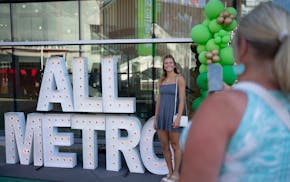Sitting at a sidewalk table, shaded by green awnings at the Cafe La Selva, I sipped chai tea laced with sweetened condensed milk and thought about the question almost everyone asked when I mentioned I'd be spending a few days in Mexico City.
"Is it safe?"
Travelers' warnings reinforce images of a city whose reputation as the cultural capital of Latin America has been overshadowed by crowds, pollution, petty street crime and, lately, worries about drug-related violence spreading inland from the border towns:
Don't flag down a taxi, especially the green VW Beetles, or risk an "express kidnapping," when a driver diverts a passenger to an ATM for an emergency cash withdrawal.
Don't carry a credit card.
Beware of pickpockets on the subway.
Yet, here I was, surrounded by locals chatting with friends or reading newspapers, feeling more like I was on a chic street corner in Madrid than in a hectic metropolis of more than 20 million. The neighborhood is Colonia Condesa, a fashionable area filled with art-deco houses and tree-lined pedestrian paths along the medians of busy main streets.
In the Parque Mexico a few blocks from the Selva, a group practices tai chi next to a duck pond and a statue of a nude woman holding two jugs with water spilling into a fountain. Taxis park next to a French restaurant across the street from the Red Tree House, a boutique B&B where $85 buys a room that opens into a plant-filled courtyard and comes with tamale breakfasts.
"There are some grim truths in Mexico these days," American artist and writer Jim Johnston wrote in a recent post on his blog.
Johnston is the author of "Mexico City: An Opinionated Guide for the Curious Traveler," a self-published book filled with tips for discovering the Distrito Federal or DF, as the locals call Mexico City. After a few days in La Condesa, where Johnston lives, I understood what he meant when he closed his blog with this: "The violence occurring in some parts of Mexico does not turn Mexico into a violent nation."
Villages within the city
Like most big cities, Mexico City is a collection of neighborhoods. Spend some time in the colonias, as they're called, and the images of a hectic, smoggy city give way to walkable urban villages.
A few miles from the tourist zone of Zona Rosa, known for its discos, bars and high-rise hotels, a group of well-dressed Mexicans sip wine and clap and sing as a guitarist serenades at La Bodega, a restaurant and music club in a mansion decorated with stained-glass windows and stools nailed to wooden walls.
Johnston compares the atmosphere to Greenwich Village in the '60s. It's a description that could apply to all of La Condesa. Built in the 1920s and fashionable in the 1940s and 1950s as home to Mexican film stars, "it's always had a bohemian artists community living here," he says.
Wealthier residents moved on after an earthquake in 1985, leaving Condesa's art deco-style buildings vacant and its parks and shady squares deserted. Now the neighborhood is hip again, with a mix of expats and locals filling sushi bars and Italian restaurants.
A few blocks away, the lines form at 11 a.m. at a taco stall called Hola where the specialty is $1.50 servings of stewed vegetables and meats stuffed into corn tortillas.
Secret gardens behind walls
Red Tree House owners Jorge Silva and his partner, Craig Hudson, a theater scenery and lighting designer from Ashland, Ore., gather their guests each evening to share wine and conversation. Everyone compares sightseeing and restaurant tips, then sets off on foot for a late dinner. "Part of the fun for us is that the city's almost always better than most people expect," says Hudson.
I realized this on a cool fall night while sitting at a neighborhood taco chain called El Tizoncito. The specialty is tacos al pastor -- tacos "shepherd style," a Mexican take on the Middle Eastern gyro.
Servers take orders and serve beer while a grillman shaves thin slices from a spit-roasted chicken topped with pineapple. Served on miniature tortillas garnished with onions, pineapple, cilantro and lime, the tacos sell for about $1 each. Nobody eats just one.
Six or so miles south of downtown, the colonial neighborhoods of Coyoacan and nearby San Angel draw crowds on the weekends when tourists and locals hunt for bargains in the craft and antique markets.
San Angel draws hordes on Saturdays for Bazar Sabado, an indoor arts and crafts market that spills out onto the streets around Plaza de San Jacinto. Others come to see the mummified bodies in the crypt of a 17th-century convent, now the Museo del Carmen. Next door, Churrerias del Convento fortifies museum-goers with hot chocolate and churros, deep-fried dough rolled up, dusted with sugar and snipped into bite-sized lengths.
At four for $2.50, including hot chocolate, this is a bargain like almost everything else is in Mexico as the dollar has gained strength against the peso.
Memo to those in need of liquid courage before heading off to view the mummies: Tequila shots are extra.

What to know about the latest COVID variants, Minnesota testing, vaccines
Sign up for Star Tribune newsletters

126 birds on list 'lost to science'

